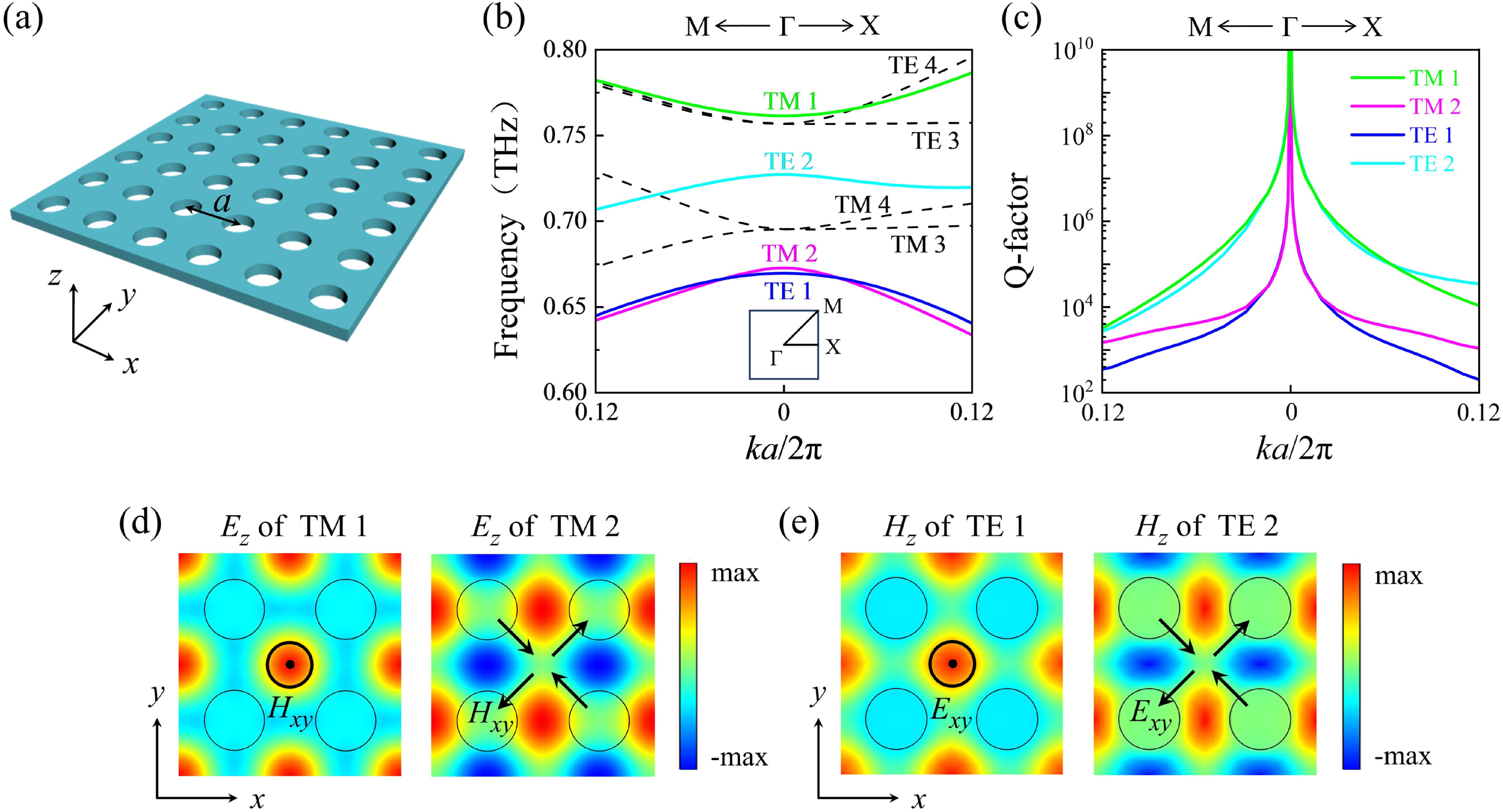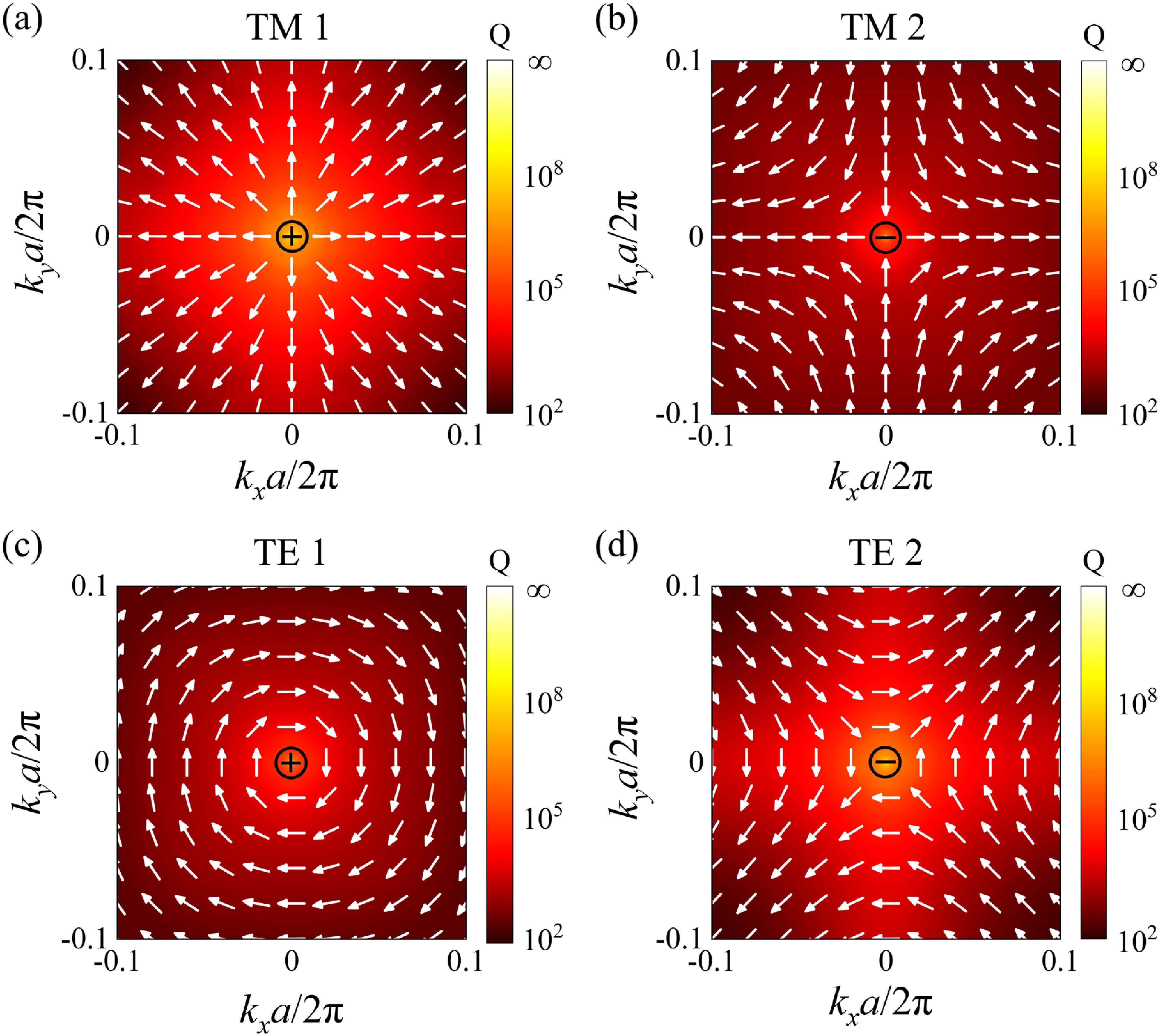Zixu Song, Yuying Wang, Jianjun Liu, Guiming Pan, Fangzhou Shu, Yong Du, Bin Fang, Zhi Hong, "Tailoring bound states in the continuum in symmetric-breaking terahertz photonic crystal slabs," Chin. Opt. Lett. 23, 023601 (2025)
Search by keywords or author
- Chinese Optics Letters
- Vol. 23, Issue 2, 023601 (2025)

Fig. 1. (a) Schematic of a terahertz PhC slab with an array of air holes in a silicon plate. The periods in the x and y directions are a = 150 µm, the radius of the air holes is r = 40 µm, and the thickness is t = 150 µm. (b) Dispersion curves of eight related TM and TE eigenmodes, as a function of ka/2π, where k represents the propagating constant. The inset shows the first Brillouin zone of the square lattice. (c) Q-factors of TM 1, TM 2, TE 1, and TE 2 modes along the M–Γ–X direction. (d) Near-field distributions of TM 1 and TM 2 at the Γ-point, where the color represents the electric field component Ez and the black circle and arrow represent the magnetic field vector. (e) Near-field distributions of TE 1 and TE 2 at the Γ-point, where the color represents the magnetic field component Hz and the black circle and arrow represent the electric field vector.

Fig. 2. Q-factors and polarization field distributions of (a) TM 1, (b) TM 2, (c) TE 1, and (d) TE 2 in momentum space. The Q-factors of these modes at k = 0 approach infinity (highlight), i.e., BIC. The rotation of the polarization vector around the BIC in the polarization field forms a counterclockwise closed loop, resulting in opposite topological charges of +1 for TM 1 and TE 1, and −1 for TM 2 and TE 2.
Fig. 3. (a), (d) Oblique s- and p-polarized incidences on the PhC slab, with dotted lines representing the air holes. (b), (e) Transmission spectra as a function of the incident angles θ and φ. (c), (f) Relationships between Q-factors of quasi-BICs and incident angles. The insets show that the Q-factors of the quasi-BICs follow Q ∝ k−2.
Fig. 4. (a) Diagram of a C2 symmetry-breaking PhC slab illuminated by a terahertz wave at normal incidence; symmetry breaking is manifested as an extension of L in the ±x directions of the circular air holes marked in red, and the asymmetry parameter α = 2Sred/Scircle. (b), (c) Resonance frequencies and Q-factors of TE 1 and TE 2 with respect to α for x-polarized normal incidence. (d), (e) Resonance frequencies and Q-factors of TM 1 and TM 2 with respect to α for y-polarized normal incidence.
Fig. 5. Dispersion curves of TE 1 at three different thicknesses when α = 0.11.
Fig. 6. (a), (b) SEM images of the fabricated PhC slab with L = 0 µm and L = 60 µm, respectively. (c) Schematic of the experimental setup to measure the THz spectra of PhC slabs.
Fig. 7. (a), (c) Measured and simulated transmission spectra of the symmetric PhC slab (L = 0 µm) under s- and p-polarized THz oblique incidences, respectively. (b), (e) Enlarged views and Fano fitting of the measured quasi-BIC (TE 2) and quasi-BIC (TE 1), respectively. (d), (f) Measured and simulated transmission spectra of the asymmetric PhC slab (L = 60 µm) under x- and y-polarized THz normal incidences, respectively.
|
Table 1. Measured Frequencies and Q -Factors of Quasi-BICs and GMRs

Set citation alerts for the article
Please enter your email address



